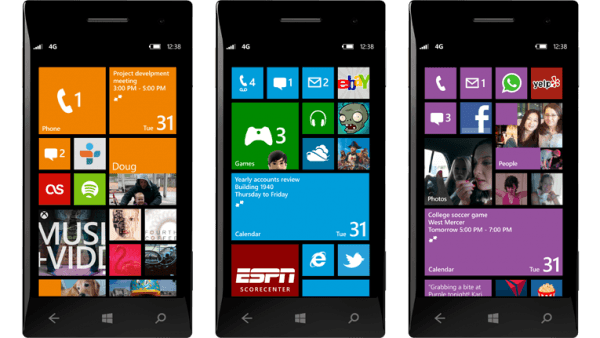Microsoft's Windows Phone Developer Summit kicked off just a few hours ago where the company is sharing a bit of what's coming with the next major update to their smartphone platform. Among the most noticeable changes at first glance is a redesigned home screen, which now allows every tile to be customized in one of three sizes available, and does away with the right-hand "rail" that held the link to the full app list.
Besides expanding the screen real-estate for live tiles Microsoft will also be offering more color customization and personalization options for the new Start Screen in Windows Phone 8.

Skype and VoIP
VoIP functionality will be baked into the operating system, but rather than just offering native Skype integration, Microsoft is adding a background agent that can handle incoming and outgoing calls as well as messaging and integration with several of Windows Phone 8 features. Skype is fully going take advantage of this and so can any other VoIP applications without favoring one over the other.
Microsoft's Greg Sullivan believes the integration is so good that he jokes Apple should create its own FaceTime app on Windows Phone 8, and it would work better than it does on the iPhone.
Internet Explorer 10, Nokia Maps
Windows Phone 8 will of course include Internet Explorer 10, which is based on the same desktop code used in the Windows 8, offering four times faster javascript performance and full HTML5 support. It will also bring over some security-related improvements, like a phishing filter and the SmartScreen URL reputation system.
Nokia mapping information will be a key part of Windows Phone 8 going forward. Although this means the Finnish phone maker will be surrendering one of the advantages it had over competing Windows Phone OEMs, the move will ensure a good mapping experience on every Windows Phone 8 device. It will include support offline maps, turn by turn directions, and all third part apps will be able to access mapping data.
A shared core
The new Windows Phone 8 platform will share common code with the Windows 8 desktop OS. Stuff such as the kernel code, file system, networking services, media foundation, device drivers, and parts of the security model from Windows 8 will be shared between the two platforms. Microsoft is calling this the 'Windows Core' and it will enable developers to port their apps between the two platforms without re-writing a lot of code.
Developers will get access to new tools and an updated SDK later this summer that are based on Visual Studio 2012 --- supporting apps for both Windows Phone and Windows Phone 8.
Despite this change all existing Windows Phone apps will continue to run on Windows Phone 8. On the downside, however, current Windows Phone 7.5 and earlier devices will not be able to upgrade to Windows Phone 8 --- as has been rumored for months. Instead, the company plans to rollout a Windows Phone 7.8 update that will bring some of Windows Phone 8's changes to existing devices.
Dual-core processors, NFC, microSD support
Microsoft is also expanding the hardware specifications that Windows Phone 8 supports, allowing manufacturers to deliver more powerful solutions to challenge the iPhone and high-end Android devices. The platform will support dual-core devices this fall and quad-cores sometime after that --- in fact, one of the hardware implications of the 'Windows Core' is that WP8 in theory will support up to 64-core chips.
Windows Phone 8 will also support more powerful GPUs and three screen resolutions: the current WVGA (800 x 480), WXGA (1280 x 768) and true 720p (1280 x 720). These will have similar aspect ratios (two at 15:9 and one at 16:9) to ensure there's no issue with applications not looking properly all devices.

Another noteworthy addition is NFC support and Microsoft's own Mobile Wallet Hub. The latter is designed to support NFC payments and the ability to store credit card information, member cards, and frequent flyer cards. It is sort of a hybrid between Google Wallet and Apple's Passbook, and apparently Microsoft already has several carriers and financial institutions on board with its payments solution.
Additionally, there's a new feature called Tap + Send that allows seamless content sharing between NFC-enabled Windows Phone 8 devices, similar to Android's Beam function.
Microsoft is also adding full SD card support to Windows Phone 8, allowing users to transfer music, photos, video, and even install applications just like they would with removable external storage in Windows PCs.